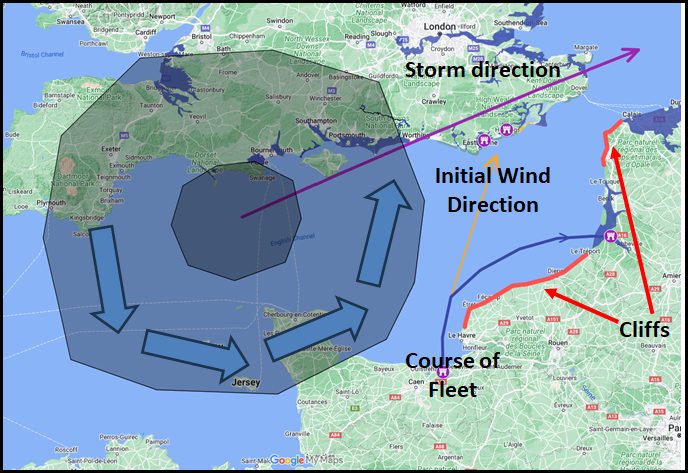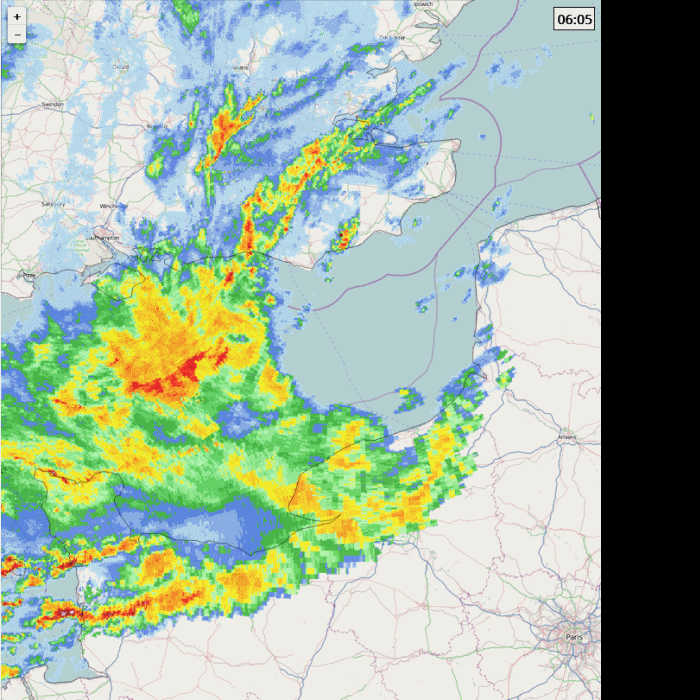|
 | Anglo Saxon History |  | |
| | Battle of Hastings 1066AD - D - Sailing - Dives sur Mer to St Valerie |
|---|
| | List of Contents |
|---|
| | |
|---|
| Dives to St Valerie ▲ |
|---|
There is only one Chronicle referring to this event, so it is not corroborated hence shown in red:
There is very little documentary evidence for this part of the journey, however the following is from the 'The Gesta
Guillelmi of William of Poitiers':
Presently the whole fleet, equipped with great foresight, was blown from the mouth of the Dives and the neighboring
ports, where they had waited for a south wind to carry them across, and was driven by the breath of the west wind to
moorings at Saint-Valery.
There too the leader, whom neither the delay and contrary wind nor the terrible shipwrecks nor the craven flight
of many who had pledged their faith in him could shake, committed himself with the utmost confidence of prayers, gifts
and vows, to the protection of heaven.
Indeed meeting adversity with good council, he concealed (as far as he could) the loss of those who drowned, by
burying them in secret; and by daily increasing supplies he alleviated want. By divers encouragements he retained
the terrified and put heart into the fearful.
|
The trip from Dives appears to have been very bad, so most likely the wind started from the South
which would take the fleet into the Channel and then the wind veered to the West and built up into a storm which blew
the fleet along the Normandy Coast to St Valerie, where a large number of ships were destroyed.
The daily increase in supplies could have meant that the fleet support ships had been wrecked and that William was
desperately trying to get supplies from the towns near to St Valerie. These would all take time to reach the port, but
as time passes more and more would reach St Valerie.
Master Wace has a different version
The duke rejoiced greatly at receiving the gonfanon, and the license which the apostle gave him. He got together
carpenters smiths and other workmen, so that great stir was seen at all the ports of Normandy, in the collecting of wood
and materials, cutting of planks, framing of ships and boats, stretching sails, and rearing masts, with great pains and
at great cost. They spent all one summer and autumn in fitting up the fleet and collecting the forces; and there was no
knight in the land, no good Serjeant, archer, nor peasant of stout heart, and of age for battle, that the duke did not
summon to go with him to England: promising rents to the vavassors, and honors to the barons.
When the ships were ready, they were moored in the Somme at St Valeri, and there delivered to the barons. Many were the
ships and boats in the river there, which is called the Somme, and separates Ponthieu and Vimou. Vimou extends as far as
Ou, which separates Normandy from Vimou, a country under different government. Ou is a river, and Ou is also a fair
castle situate upon that river.
Master Wace Chronicle was written some time after the event so the story of the storm and loss of
life may have been removed by William.
As St Valerie was not part of Normandy then it would seem unlikely that William would risk his ships being brought
together in a foreign country, and Dives would seem more likely.
There is another issue with St Valerie, as it is close to the coastal cliffs of Northern France the wind needs to come
from the South or South East for sailing ships to leave the Somme estuary safely, whereas in Dives you can leave the
harbour with a South West, South or South East breeze. The prevailing wind in the Channel is South West hence Dives is a
better harbour to sail from.
| 
The above map shows a possible scenario that explains why William's fleet landed at St Valerie sur Somme.
The first piece of information is that the storms in the Northern hemisphere rotate in an anti-clockwise manner.
The Normans leave Dives with a South West wind heading towards Pevensey (orange line) as they reach the Channel the
storm moves quickly up the channel (purple line). The wind would then veer to the West and push the ships along the
Alabaster Coast. As they start to get towards St Valerie, the storm would then make the wind direction change from West
to North West pushing the ships towards the cliffs on the French Coast (shown in red). The faster ships with rowers
carrying the troops would probably made it to St Valerie, but the slower non oared supply ships would have been wrecked
probably between Dieppe and Le Treport by being blown onto the cliffs.
| 
This is an animation of Storm Benjamin that passed by 23/10/2025 that shows the wind changes along the French coast and
in the Channel, this animation is based on a time lapse from https://www.netweather.tv, and shows the type of storm from
the last image.
| | Damage to the Fleet between Dives and St Valerie ▲ |
|---|
There are two sources of information regarding the vessels sailing to Britain, the first is the The Ship list of William the
Conqueror which describes the Williams Fleet presumably before leaving Dives with 777 ships.
The second reference is from Master Wace who reports'but I heard my father say I remember it well, although I
was but a lad that there were seven hundred ships, less four, when they sailed from St. Valeri ; and that there were
besides these ships, boats and skiffs for the purpose of carrying the arms and harness. I have found it written (but I
know not whether it be true) that there were in all three thousand vessels bearing sails and masts. Any one will know
that there must have been a great many men to have furnished out so many vessels.'
| | Conclusion ▲ |
|---|
If the Williams Ship List showing 777 ships and Master Wace's 694 ships leaving St Valerie are true
then the fleet would have lost 81 ships between Dives and St Valerie.
This would have been over 10% of the fleet, which would make the report from William of Poitiers of concealment of the
drowned fairly important, as there would have been a significant number possibly in the hundreds of troops, horses and a
great deal of supplies.
| | This is what the DeepSeek AI output ▲ |
|---|
My Question:
Is it probable that the Norman fleet in 1066AD was blown by a storm from Dives sur Mere to St
Valerie ?
The Norman fleet's journey in 1066, as part of William the Conqueror's invasion of England, is a well-documented
historical event. According to historical accounts, the Norman fleet did experience a storm that forced it to divert
from its original departure point at Dives-sur-Mer to Saint-Valery-sur-Somme. This storm is often cited as a significant
event in the lead-up to the Battle of Hastings.
Key Points:
Departure from Dives-sur-Mer:
William the Conqueror assembled his fleet at Dives-sur-Mer in Normandy, where they waited for favorable winds to
cross the English Channel.
The Storm:
Historical records, such as the Bayeux Tapestry and chronicles like those of William of Poitiers, mention a storm
that scattered the fleet and caused significant delays.
The storm likely occurred in September 1066, forcing the fleet to seek shelter and regroup.
Relocation to Saint-Valery-sur-Somme:
After the storm, William moved his fleet north to Saint-Valery-sur-Somme, a port with better wind conditions for
crossing the Channel.
This relocation was strategic, as Saint-Valery was closer to England and provided a more favorable launching point
for the invasion.
Historical Probability:
The storm and the fleet's diversion are considered historically probable, as they are supported by multiple
contemporary sources.
The English Channel is known for its unpredictable weather, and storms in this region are common, especially in late
summer and early autumn.
Impact on the Invasion:
The delay caused by the storm allowed Harold Godwinson, the English king, to mobilize his forces and prepare for the
Norman invasion.
However, Harold's army was later weakened by the need to march north to repel Harald Hardrada's invasion at the
Battle of Stamford Bridge, just before facing William at Hastings.
Conclusion:
It is highly probable that the Norman fleet was blown off course by a storm in 1066, forcing it to relocate from
Dives-sur-Mer to Saint-Valery-sur-Somme. This event is well-documented and aligns with the known weather patterns of the
English Channel. The storm played a crucial role in the timing and logistics of William the Conqueror's successful
invasion of England.
|
|
|
|
|
|
| |
|
|
Local Interest
Just click an image |
|
|
|
|
|
|
|
|
|
|
|
|
| |
|
|